
Columbia, 15 Chapters, 1949. Starring George Reeves, Charles King, Don Harvey, William Fawcett, John Merton, Nelson Leigh, Leonard Penn, Hugh Prosser, Jim Diehl, Pat Barton, Pierce Lyden, and Paul Frees as the voice of the Black Knight.
In the days of good King Arthur (Nelson Leigh), a young man named Galahad (George Reeves) journeys to Camelot in hopes of joining the Knights of the Round Table. He wins the king’s favor by distinguishing himself in a tournament–but, to qualify for full knighthood, he must first prove his worthiness by keeping a night-long watch over Arthur’s magic sword Excalibur; he fails in this task when a mysterious traitor within the walls of Camelot drugs him, subsequently stealing the priceless sword. When the theft is discovered, Galahad is accused of treason by members of Arthur’s court; Arthur himself gives Galahad the benefit of the doubt, but withholds his knighthood. Galahad sets out to set things straight by recovering Excalibur, aided by the roguish but trustworthy knight Sir Bors (Charles King); their quest quickly leads them into conflict with several formidable adversaries–the invading Saxon king Ulric (John Merton), who’s determined to use Excalibur to conquer Britain; Merlin, who appears to be secretly working against Arthur; and the unknown traitor who first stole the sword, actually a member of the Round Table, who’s assumed the guise of the “Black Knight” to further a scheme for seizing Arthur’s throne.
Adventures of Sir Galahad represents its producer Sam Katzman’s second and last attempt to combine the serial and medieval-swashbuckler genres; it’s a huge improvement over Katzman’s previous effort in the same line, the shoddy and tedious Son of the Guardsman–even though Galahad and Guardsman have many sets, costumes, and actors in common. Galahad’s use of the classic Arthurian mythos is one reason for its greater appeal; the presence of immediately recognizable figures like Arthur, Lancelot, Modred, and Galahad immediately makes the serial’s milieu much more interesting than the “generic medieval” setting of Guardsman. The supernatural elements of the Arthur saga–Merlin, Arthur’s sorcerous sister Morgan le Fay, the sword Excalibur, the Lady of the Lake– also lend a fantastic and unpredictable tone to the action that was missing in the mundane Guardsman. However, this isn’t to say that Galahad doesn’t have its own share of weaknesses; it does, most of them in the scripting department.
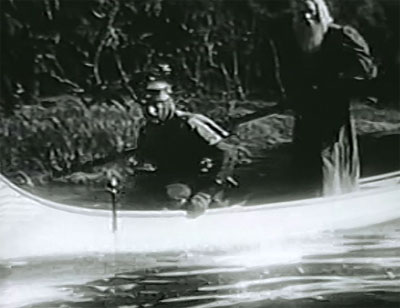
Above: Arthur and Merlin first acquire Excalibur, in a striking flashback scene that looks as if it came straight out of Howard Pyle.
The dialogue itself isn’t bad, though; the writers let some awkward-sounding or anachronistic lines creep into the script, but also do a solid job of coming up with colorful and fairly unlabored “medieval” lines for their characters (“You ask for nothing, yet you drool like a hound before the kill.”) The basic plot of Galahad is also serviceable enough–a typical serial MacGuffin hunt, with Excalibur taking the place of a death-ray or lost treasure. Writers Lewis Clay, David Mathews, and George Plympton keep the somewhat repetitive quest for the sword from becoming too repetitious by introducing a good plot twist at the serial’s one-third mark; in Chapter Six, both Arthur’s and Ulric’s forces realize that they’ve been fighting over a bogus Excalibur–a discovery that shakes up the plot by putting the Saxons (hitherto the principal antagonists) into the background, and concurrently bringing the Black Knight (kept almost entirely off-stage until Chapter Seven) to the fore as the serial’s main villain.

Above: Saxon king Ulric (John Merton, right) and his aide Bartog gloat over a sword that they think is Excalibur.
The Saxons are deftly brought back in later chapters, challenging both Galahad and the Black Knight whenever the plot is in need of another twist, but never becoming so prominent that they turn the serial into a villain-on-villain duel. The seeming double-dealing of Merlin is also used to keep the storyline varied, but far less successfully; the wizard’s reasons for plotting with the Saxons, attempting to destroy Galahad, and (later) hiding Excalibur are never satisfactorily explained, and his eventual declaration that he’s always been on the side of the heroes is none too convincing (it sounds even less believable than similar last-minute “explanations” by the red-herring characters in various Mascot serials). Morgan le Fay, not the evildoer here that she was in the classic Arthurian stories, behaves in less threatening but equally confusing style, sometimes lending aid to Galahad and sometimes causing trouble for him.

Above: William Fawcett’s Merlin watches as Pat Barton’s Mogan le Fay casts a spell.
Merlin’s bizarre behavior appears to confuse the writers too; at least, it causes them to temporarily lose track of Excalibur during the last three chapters (after the schizophrenic sorcerer makes it vanish in Chapter Twelve, during one of his magical attacks on Galahad). The villains confidently but inexplicably assert that they have the sword a few chapters later, only to find it gone; Merlin then reveals it’s been returned to its original owner, the Lady in the Lake, and sends Galahad on a dangerous journey through an enchanted forest to recover it–a journey that seems a bit pointless, since Merlin has earlier demonstrated an ability to make Excalibur appear out of thin air. Ultimately, Merlin’s contradictory magic tricks serve little purpose other than to make the serial’s narrative occupy fifteen chapters; one is left with the definite impression that the seemingly omnipotent wizard has been needlessly prolonging the hero-villain struggle for his own warped amusement. It would have been a much better idea to simply make Morgan le Fay the full-blown villainess she was in the Arthurian legends, and have her–not Merlin–wreak magical havoc on Galahad; Merlin himself could then have displayed his own magical powers by countering Morgan’s spells, instead of by repeatedly hexing Galahad.


Above: Merlin conjures up three phantom knights to attack the (off-camera) Galahad.
It’s a shame that Galahad’s plotting is so scrambled, since the serial is quite solid in other departments. Though it’s expectedly padded in a few places (by a couple of unnecessarily protracted riding and spying scenes, and by a horrendously inappropriate dance number in the first chapter), it moves at a pretty good pace for a Katzman serial, while its medieval-style action scenes are both interestingly offbeat and well-executed. The lively Chapter Seven duel in the dungeon is particularly good–and is additionally enhanced by rousing accompanying music; other sword-fighting highlights include Chapter Two’s duel between Galahad and a phantom knight in the Enchanted Forest, the Chapter Three battle between Britons and Saxons, the clash between Galahad (temporarily supported by the Saxons) and the Black Knight’s forces in the inn-yard in Chapter Ten, and the climactic Chapter Fifteen battle at Camelot.

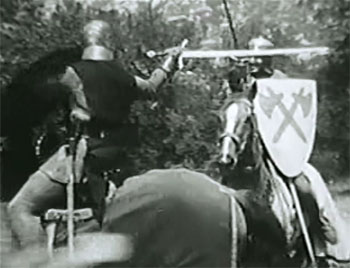


Above, top left: Galahad’s Chapter Two sword duel in the “Enchanted Forest.” Top right: Ulric and Sir Lancelot clash during the Chapter Three battle. Bottom left: Galahad and Sir Bors take on Bartog and the Black Knight in the Chapter Seven dungeon duel. Bottom right: The Chapter Ten battle in the inn’s courtyard.
Spencer Bennet does a far better job of staging these and other swordfights than Derwin Abrahams did in Son of the Guardsman; the veteran action director has both his actors and his stuntmen (George DeNormand, Eddie Parker, George Robotham) energetically leap, lunge and slash at each other during one-on-one duels, instead of remaining boringly planted on their feet. Though the larger-scaled battle scenes are sometimes marred by the obvious fencing clumsiness of many of the participants, they’re also shot with plenty of skill and flair; unlike Abrahams, who tended to film such combats in uninterrupted long shots, Bennet does a lot of lively back-and-forth cutting between individual combatants and the battle as a whole, and also enlivens things by regularly having blades dramatically clash right in front of the camera, as other swords and swordsmen simultaneously hack at each other in the background.
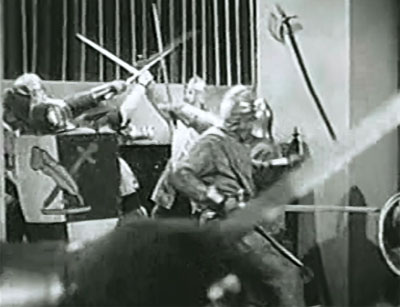
Above: A shot from the climactic battle at Camelot.
Bennett and his stuntmen do a similarly good job on the serial’s scarcer non-swordfight action scenes. Galahad’s simultaneous unhorsing of a pair of Saxons in Chapter Two (with the aid of a flagpole) is a neat bit of stuntwork; the Chapter Nine tavern fistfight, the grapple on the cliff-edge in Chapter Thirteen, and Galahad’s fight with a dungeon attendant in Chapter Fourteen are all good too (the last-named sequence is short, but unusually fierce, concluding as it does with our hero choking the villain to death with his own whip). The serial’s opening tournament sequence, though handled competently enough, is a bit too slow in tempo (probably for safety reasons; I’m sure rehearsals were minimal) to be really impressive; the challengers charge at each other with such deliberation that their steeds are able to trot to a halt almost as soon as their riders are unhorsed.

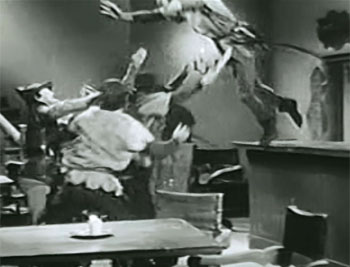
Above left: Galahad cleverly topples a Saxon from his horse. Above right: Galahad leaps onto a band of outlaws during the Chapter Nine tavern fight (George DeNormand is probably doing the stunting here).
Galahad’s chapter endings are uneven, but do include some good cliffhangers. Galahad’s trampling by the Saxons’ horses, though fine in concept, is rather embarrassingly set up by having the hero clumsily bump his head on a branch while galloping through the forest; the giant-arrow, ladder-fall, and giant-mace cliffhangers are decidedly better-executed–although the ladder scene is improbably resolved, as is the cart-off-the-cliff chapter ending. Galahad’s apparent beheading and his imperilment by a moving wall of swords are too abrupt to be entirely satisfactory; the cliffhangers in which he’s menaced by Merlin’s conjurations (a living tree and a raging fire in one ending, a trio of identical masked knights in another) are much more effectively set up, and are memorably unusual. Galahad’s fall from a towering cliff features a nicely-done resolution (a neat variation on a familiar cliffhanger escape seen in other Bennet serials), and his apparent stabbing by the villains while hiding behind an arras is made better than it sounds by a good head-on action shot of the stabbers.

Above: A living tree holds Galahad inside a raging fire at the end of Chapter One.
Columbia’s castle and tavern exteriors, built for bigger-budgeted features and also utilized–primarily as a backdrop–in Son of the Guardsman, are put to more extensive use by Galahad’s crew, giving the cheaply-produced serial some needed production value. Actors actually tread the castle walls and prowl its courtyard in various scenes, lending the fortress a more three-dimensional feel than it possessed in Guardsman; the tavern’s roof and outside staircase are also incorporated directly into the action. The Corriganville movie ranch provides most of the serial’s other exterior locations; though its rocky hills look more than a bit Californian, its many tree-filled stretches do make more believable ancient British forests than the less wooded expanses of the Iverson ranch would have; director Bennet makes particularly good visual use of a steep forest glen-side in several chapters. The Western cabin at Corriganville strikes a decidedly anachronistic note, but fortunately only figures in a couple brief scenes; interiors (the dungeons and secret tunnels, the inside of the tavern, Arthur’s throne room, the chamber of the Round Table) are well-appointed enough, even though the rooms of the fabled Camelot probably should look a little more spacious than Katzman’s budget allows them to.


Above left: A duel on a stream bank at Corriganville. Above right: Bartog gallops into the courtyard of Camelot.
Future television Superman George Reeves is too mature to portray a character who’s continually referred to as a “youth,” a “lad,” or a “puppy”–but does an excellent job in Galahad’s title role nonetheless; he plays his part with such conviction, energy, and self-assurance that he easily minimizes the incongruous aspects of his role. He’s urgently earnest when trying to convince Arthur’s knights of his trustworthiness, believably perplexed and alarmed when confronted with magical phenomena, slyly sarcastic when parleying with suspicious characters, aggressively forceful when facing down villains or preparing for action, and likably jovial in his interactions with his rascally friend Sir Bors.

Above: George Reeves prepares to stand off a threat.
Veteran heavy Charles King has a rare sympathetic role as Bors, and is a delight to watch; he provides first-rate humor through his fondness for food and comfort, his assumptions of comical disguises, and his startled reactions to various enchantments (particularly during his encounter with a living tree)–but is never a complete bumbler; he also holds his own in swordfights and dignifiedly speaks up on behalf of the maligned hero. Though he genially reacts to Galahad’s impatient quips at his expense in some scenes, he’s serious and almost fatherly in other interchanges with the hero; his well-balanced performance creates the impression that he tolerates Galahad’s impetuosity and outspokenness because he’s genuinely fond of him, just as Galahad tolerates Bors’ laziness and gluttony–lending some unusual depth to what would otherwise have been a standard hero/sidekick relationship.

Above: Charles King reacts delightedly to a (unfortunately illusory) feast that he finds in the depths of the Enchanted Forest.
Though William Fawcett can’t make sense of his poorly-written Merlin, his scene-stealing turn as the wizard is still extremely enjoyable–whether he’s laughing maniacally, gesturing weirdly as he casts spells, or making peremptorily grim and haughty remarks. Don Harvey has one of his biggest and best serial roles as the cunning Bartog, who first serves as King Ulric’s lieutenant and then transfers his allegiance to the Black Knight; he plays this scheming character well, exchanging his typically laid-back manner for a haughty but cynically crafty air. As Ulric himself, John Merton chews the scenery to appropriate and entertaining effect–enthusiastically snarling, bellowing, chortling, and swaggering with all the ferocious confidence one would expect from a barbarian warlord.


Above left: John Merton. Above right: Don Harvey.
Nelson Leigh’s dignified bearing and grave, resonant voice give him the strong presence necessary for the role of King Arthur–although he spends most of his screen time on the serial’s sidelines. Jim Diehl’s authoritativeness and stone-faced humorlessness serve him well in the role of Arthur’s stubbornly upright (and irritatingly uptight) seneschal Sir Kay; Hugh Prosser is much more good-natured and likable, though suitably stalwart, as Sir Lancelot. Leonard Penn is his usual saturnine self as the urbane but arrogant Sir Modred, sneering condescendingly whenever Galahad tries to present his case to Arthur. As Sir Gawain, Rick Vallin gets the short end of the knightly stick where screen time is concerned, receiving almost no dialogue (although he does figure silently in several action scenes).
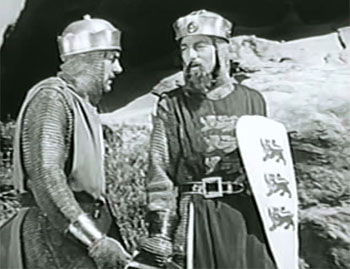

Above left: Nelson Leigh (with lion shield) approvingly comments on Galahad to Hugh Prosser. Above right, left to right: Jim Diehl, Leonard Penn, and William Fawcett in Arthur’s throne room.
Galahad has no real leading lady, even though it features no fewer than three credited actresses in its cast. Sophisticatedly attractive Pat Barton only figures in about a half-dozen scenes as Morgan le Fay, but is the most prominent of the three; she gives her sorceress a properly smug and slinky manner, although she can’t do much else with the underwritten and inconsistent character. Marjorie Stapp is pretty and breezily cheerful in her occasional appearances as Queen Guinevere, while Lois Hall receives fifth billing but only three short scenes as the benevolent and mystical Lady of the Lake; a rather chintzy-looking white robe keeps her from looking as ethereal as she should, but her graceful beauty still makes an impression.
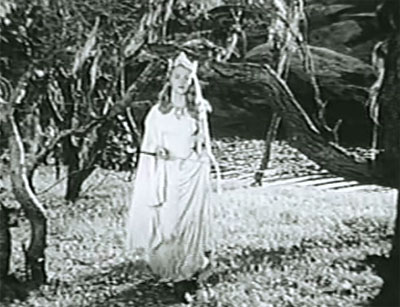
Above: Lois Hall as the Lady of the Lake appears with Excalibur.
The villainous Black Knight is distinguished not only by his forbidding and face-concealing helmet but by his sinister and boomingly self-confident voice, which is provided by none other than famed narrator and voice-over specialist Paul Frees. Ironically, though the Black Knight is one of the only Columbia masked villains whose voice is provided by a second actor instead of by the player unmasked in the last chapter, he’s also one of the most easily-guessed “mystery” heavies in serial history; one wonders why Katzman and Bennet bothered to hire Frees to “disguise” the villain’s identity–even though it is nice to hear his arresting tones ringing inside the villain’s helmet.
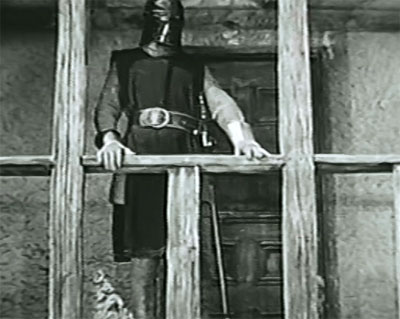
Above: The Black Knight appears on a balcony above his followers.
Dependable heavy Pierce Lyden figures prominently in the serial’s second half as a hard-bitten outlaw leader who puts his gang under the command of the Black Knight; Rusty Wescoatt and Frank Ellis are among his men, and Al Ferguson plays a Camelot man-at-arms. Former B-western and serial hero Ray Corrigan, owner of the ranch on which Galahad was filmed, picks up some extra money in an unusual but amusing character turn as a slimy and seedy innkeeper.
Katzman’s regular musical director Mischa Bakaleinikoff turns in an unusually distinctive score, cribbing cues and themes from the soundtracks of Columbia swashbuckler features like The Bandit of Sherwood Forest and The Guardsman, instead of from the Columbia Westerns he usually raided; the energetic and resounding “old English” sound of the borrowed music fits Galahad’s subject matter perfectly.
With a less illogical storyline, Adventures of Sir Galahad could have ranked as one of Katzman’s best Columbia serials–but, even though it doesn’t quite work as a whole, it still provides fine entertainment. A strong leading performance, a colorful array of supporting ones, and some novel and well-done action scenes combine to make it enjoyable and worthwhile, despite its flaws.
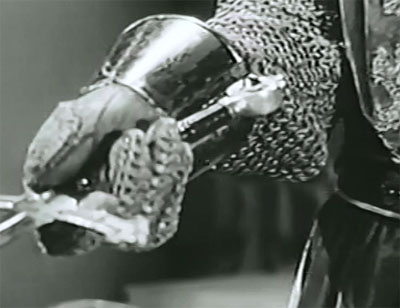
Above: The hilt of Excalibur rests once again in Arthur’s hand.
Well, I have to give the notorious cheapskate Katzman a pat on the back for this one. Considering the budget he was working with, he did a great job. I have watched several big budget, Technicolor, widescreen, Camelot movies in the last year–Knights of the Round Table, Prince Valiant, and The Black Knight–and I found this lowly serial more enjoyable than any of them despite its flaws. It has the plotting flaw you pointed out, but those big budget films weren’t brilliantly plotted either, and George Reeves was actually more convincing as a knight of the round table than Robert Taylor, Robert Wagner, or Alan Ladd. I give this one high marks both for being an entertaining serial, and for doing something different. I think that director Spencer Bennet, also, and always, deserves credit. Most of the post-1948 Katzman serials I have seen so far have from decent to above average. Bennet is probably the main reason, although Sam generally put together respectable casts, better than Republic at the same time. **** out of *****
Not exactly what Geoffrey of Monmouth might have envisioned but entertaining nonetheless less. George Reeves and Charles King make for a great pairing, and Don Harvey delivers a very good performance as the double dealing Bartog. I agree with your assessment of the Merlin character; as written it’s very confusing as to what he’s up to, and the final explanation makes little sense, but William Fawcett is fun to watch regardless. All in all, this one delivers much more than one might have expected, especially given that Katzman was involved.